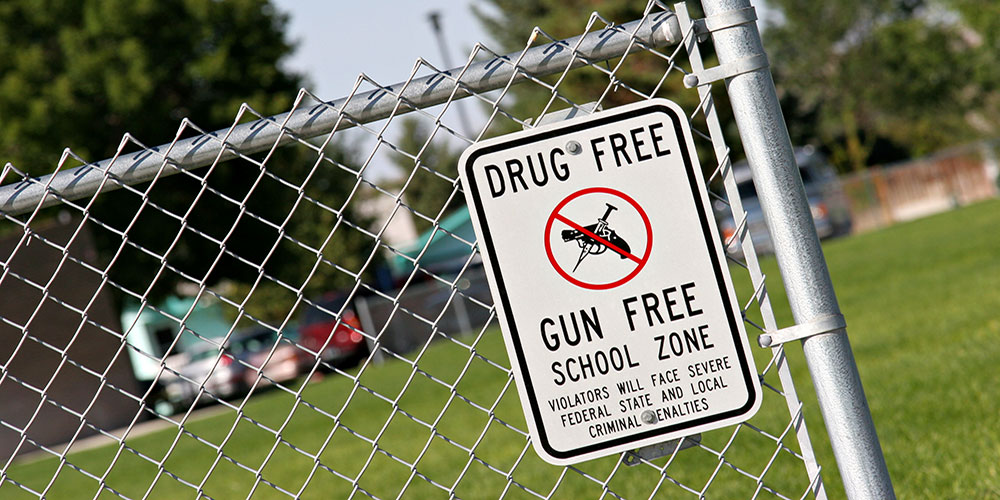This article, originally published on March 11, 2024, was updated on Jan. 22, 2025, to include 2025 statistics.
More than 850 victims have been killed by guns in American K-12 schools in the last 58 years, according to one analysis. When this article was first published in March 2024, that number was just over 800.
The K-12 School Shooting Database, maintained by researcher David Riedman, found 855 victims have been killed and an additional 2,385 have been wounded in 2,981 incidents since 1966. These findings include every instance in which a gun was fired, brandished, or a bullet hit school property regardless of the number of victims.
The author notes the number of incidents, victims, and deaths has increased dramatically in the last six years, made evident by the chart below.
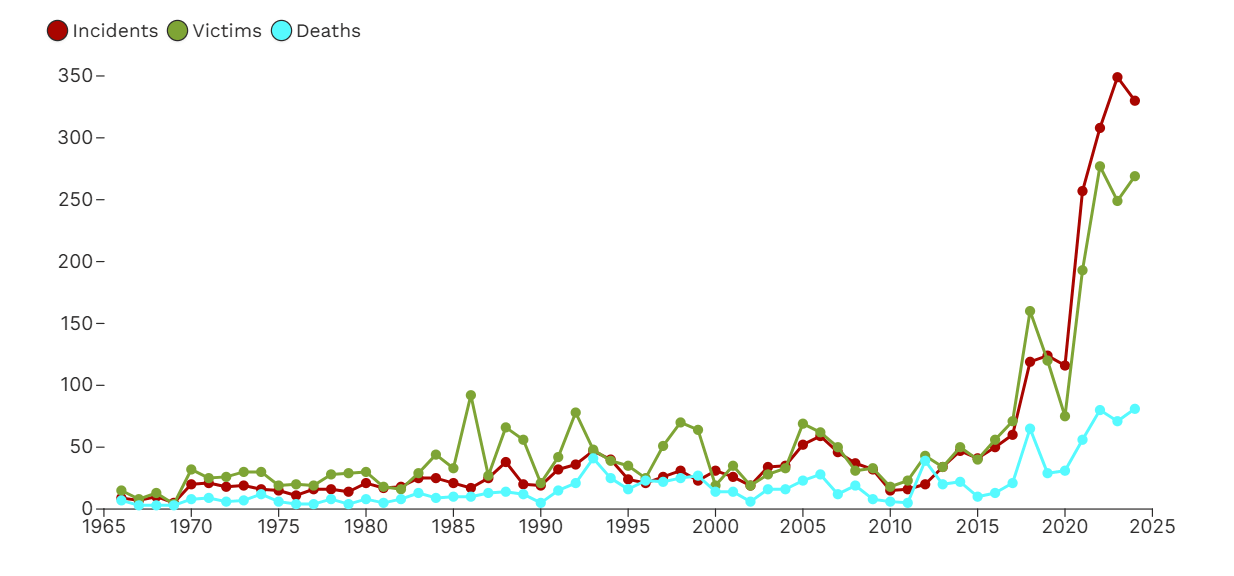
Source: David Riedman, K-12 School Shooting Database
The year 2020 saw many incidents (116) despite most schools being shut down for several months. When campuses reopened, gun violence skyrocketed to 256 incidents in 2021 and has increased every year since. In 2023, there were 349 recorded incidents. In 2024, there were 330 incidents of gun violence with 269 victims, including fatal and wounded. While 2024 had 5% fewer school shooting incidents than 2023 (330 vs. 349), there were more victims (269 vs. 249) and deaths (81 vs. 71).
Although there were fewer school shootings last year than the year prior, the number of school shootings in each of the last four years is more than 107% higher than any year prior to that for the last 25 years, according to a 2024 annual report from Omnilert.
These findings align with an investigation conducted by the Washington Post which found 51 of the country’s largest school districts reported a sharp increase in the number of firearms recovered on campus in recent years. The investigation also determined that from the 2018-2019 school year to the 2022-2023 school year, 47 districts that provided full data experienced a 79% increase in gun seizures. Overall, during the 2022-2023 school year, more than 1,150 guns were seized on K-12 campuses.
A research letter published in April 2022 in the New England Journal of Medicine also found guns were the leading cause of death for U.S. children and teens in 2020. More than 4,300 people ages 1-19 died of firearm-related injuries in 2020 — a 29.5% increase from 2019.
Most School Gun Violence Linked to Escalated Disputes
While indiscriminate active shooters have been and will continue to be the most “newsworthy,” this particular data set, similar to many others, shows most school gun violence is linked to an escalated dispute (33% or 994 incidents). Indiscriminate shootings are fifth on the list, making up 4.6% of all incidents. More common are accidental shootings (9.4%), drive-by shootings (8%), suicide/attempted suicide (5.5%), and shootings linked to illegal activities (6%).
While active shooters aren’t the most common, they have resulted in 382 injuries and 167 deaths. Of all active shooter deaths dating back to 1970, 62% have occurred in only the last 12 years, supporting Riedman’s findings that the number of victims and deaths has increased dramatically in recent years.
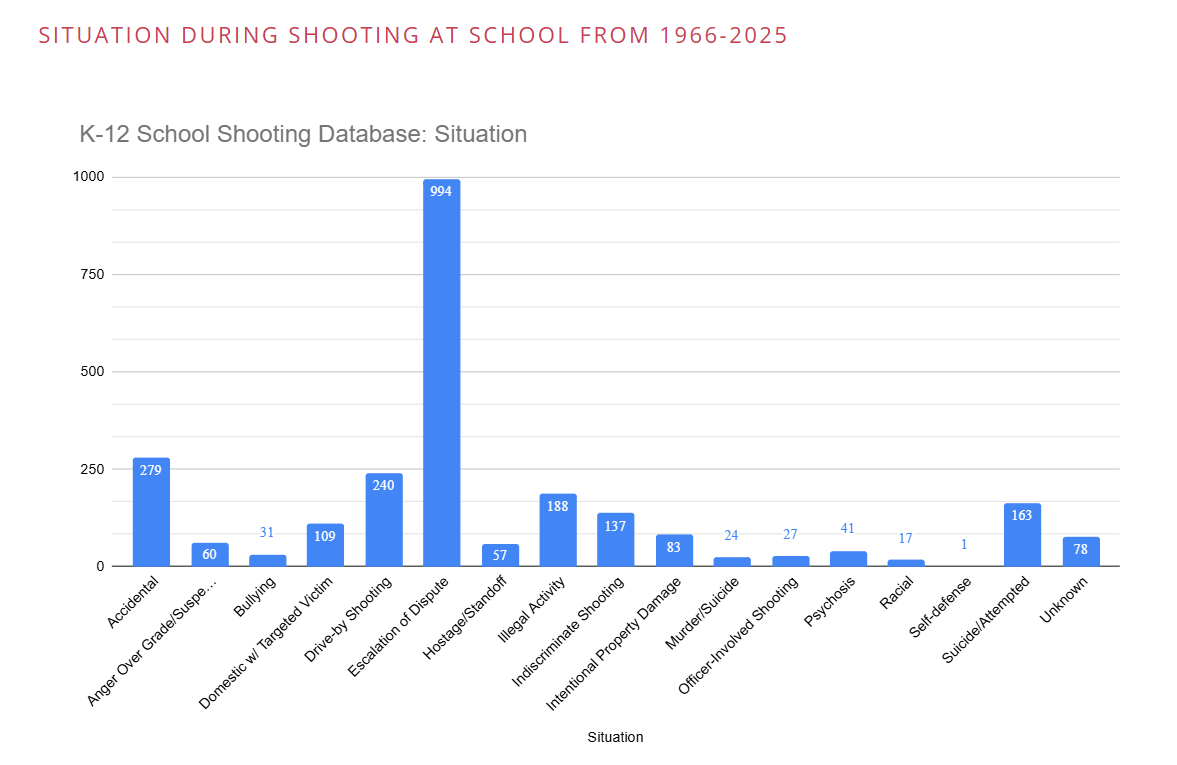
Source: David Riedman, K-12 School Shooting Database
When and Where Do Most School Shootings Occur?
The K-12 School Shooting Database also looks at the location of where school shootings occur. According to the data, most school gun violence has occurred in a parking lot (752 incidents). The next most common locations are in front of a school (330) and beside a building (254). These findings align with the fact that most day-time school shootings happen during morning classes (493 incidents) and at dismissal (352 incidents) — the times when the most amount of people congregate outside the school building.
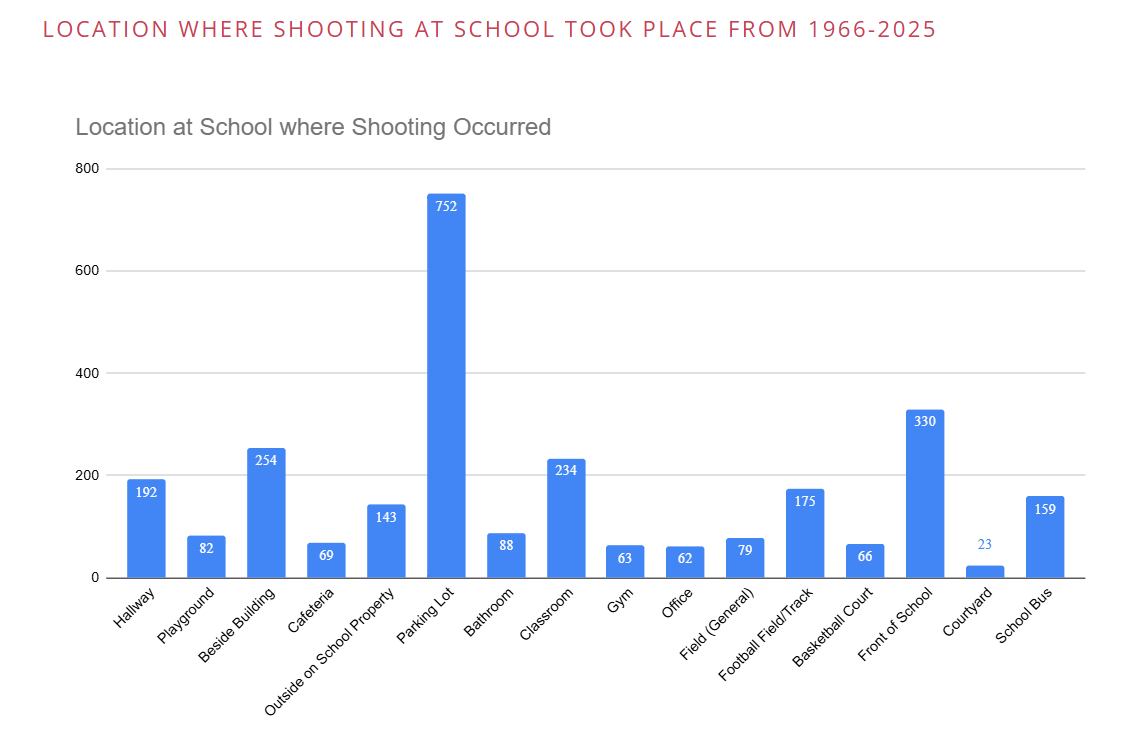
Source: David Riedman, K-12 School Shooting Database
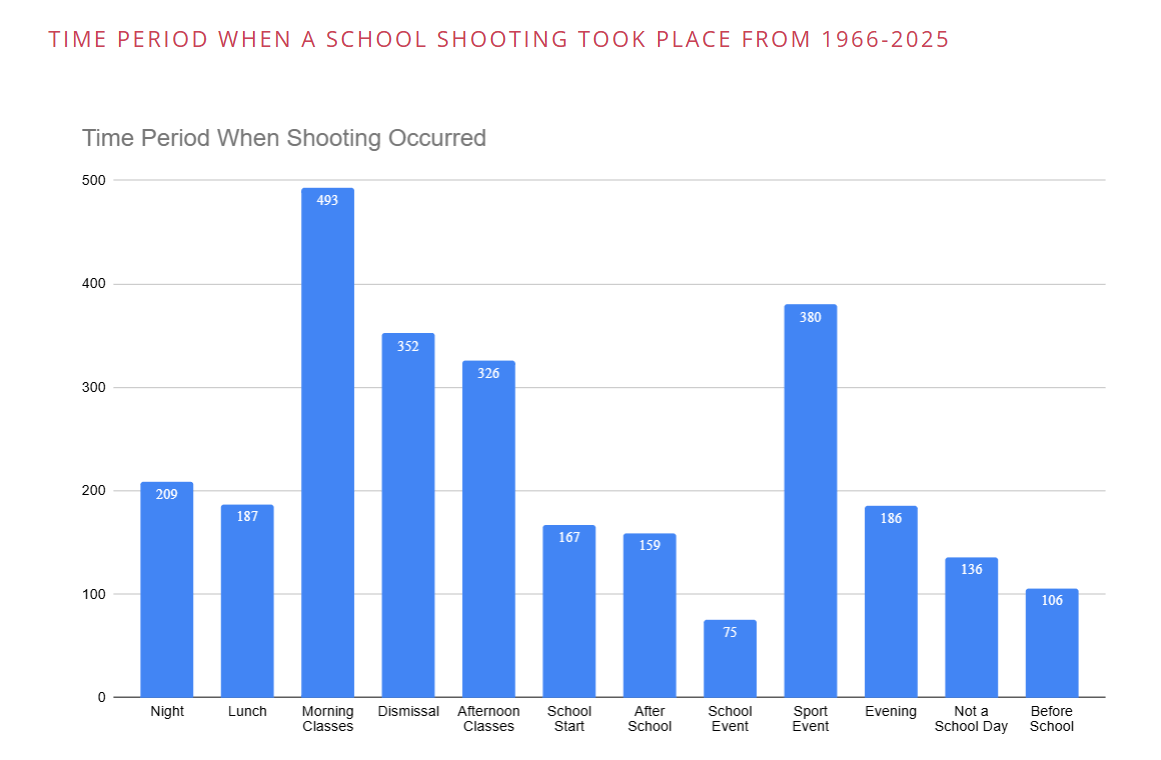
Source: David Riedman, K-12 School Shooting Database
As violence has increased in recent years, communities have called on schools to provide additional security during arrival and dismissal times. In Nov. 2021, following a spate of violence in New York City Public Schools, the Department of Education announced there would be an expansion of random metal detector scannings at 30 schools, and that more NYPD officers would be deployed to offer support during arrivals and dismissals.
More recently, in Feb. 2023, New York City Police Chief of Department Jeff Maddrey ordered more NYPD officers be pulled from administrative duties to provide extra security during dismissals for the remainder of the school year. In July 2023, all employees assigned to the NYPD School Safety Division were issued ballistic-resistant vests to be worn both inside schools and outside schools during student arrivals and dismissals.
In Worcester, Mass., a school safety task force recommended the addition of school liaison officers (SLOs) to provide neighborhood-based foot beats and offer assistance during morning arrivals and afternoon dismissals to manage increased traffic. There are now technologies available to help manage school dismissals through features such as geofencing and direct messaging.
The second-most common location for a shooting at a school is after-hours during sporting events (335 incidents), which lends itself to the previously mentioned statistic that the majority of shootings happen in parking lots. Sporting events bring together large amounts of people with various connections to two competing teams, many of which have longstanding rivalries.
Monitoring people who come in and out of these events is nearly impossible, but there are various ways crime can be mitigated at after-hours school events. Following a 2020 deadly shooting at a basketball game, the Dallas Independent School District started using metal detectors to screen attendees at its athletic events and implemented a temporary ban on all bags, purses, and backpacks.
In 2023, to better control rowdy athletic event crowds, the Southeastern Conference (SEC) announced it was doubling penalties on home teams when fans rush game fields or courts. All SEC schools must now also provide security and uniformed police presence around each team and game officials before, during, and after every game. Environmental design can also help mitigate violence.
Here are three additional resources on violence prevention and response at athletic events:
- 7 Steps to Improving Stadium and Large Event Security
- How Jeannette City School District Responded to a Fatal Stadium Shooting
- Weapons Detection System Improves Fan Experience at Ohio Soccer Stadium
Who Are The Most Common Offenders of School Gun Violence?
While schools and the media so often focus on the outsider threat, students are the most likely to perpetrate gun violence in schools, making up 43% of offenders in this study.
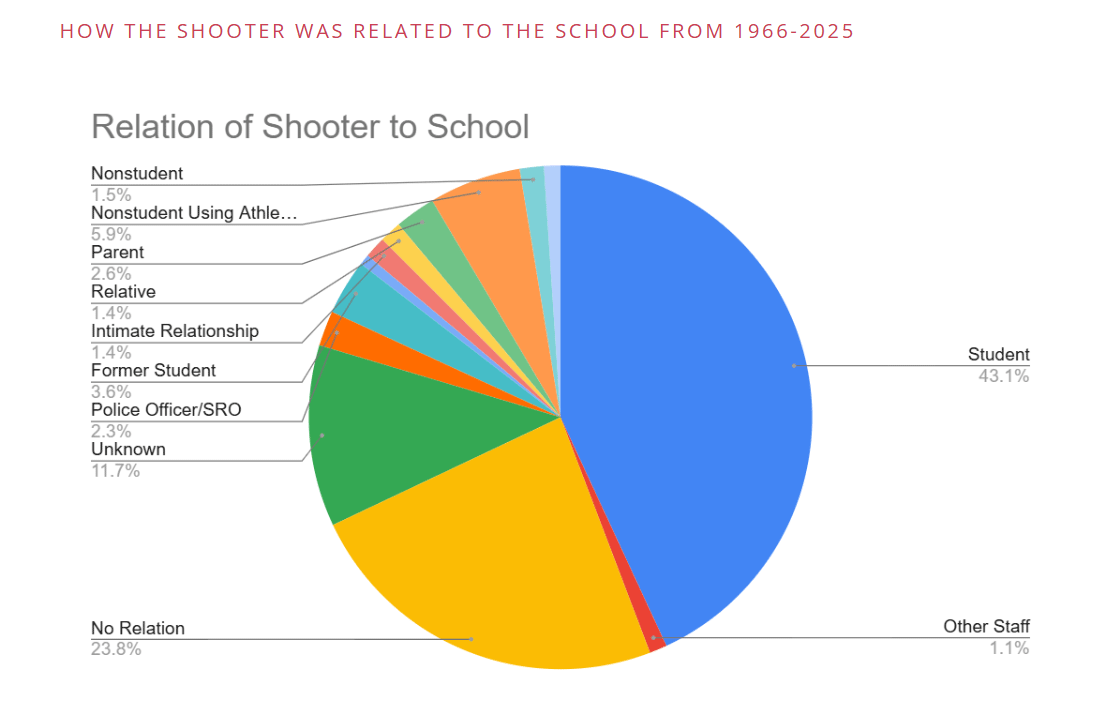
Source: David Riedman, K-12 School Shooting Database
This statistic emphasizes the importance of focusing on internal preventative measures, including behavioral threat assessments, weapons detection, anonymous tip lines, community programming, restorative justice programs, mental health support, and a campus culture that focuses on diversity, equity, and inclusion.
A 2020 targeted school violence report released by the U.S. Secret Service National Threat Assessment Center concluded most of the active shooter events that happened in the previous decade were preventable. Nearly every attacker (94%) experienced negative home life factors and most elicited concern from others beforehand (80%). Time and time again, anonymous tip lines and nurturing connections between students and a trusted adult — both in K-12 and higher education settings — have proven to improve student well-being and subsequently mitigate violence.
Here are some resources on school violence prevention:
- Pinellas County Schools Police Chief Makes Community Safer by Investing in Students’ Futures
- Behavioral Threat Assessments, Safety-Conscious Students Critical to School Violence Prevention
- Behavioral Health Director Speaks to the State of Mental Health in K-12 Schools
- Texas Schools Credit Restorative Justice Programs for Suspension Drops
- Former Oxford School Leader Shares Lessons Learned in Violence Prevention, Response and Recovery
- School Violence Prevention and Response: Lockdowns and More
Additional school violence prevention articles and resources can be found here.
Determining What Constitutes a School Shooting
We’ve covered similar findings in the past on Campus Safety, and many readers have voiced strong opinions on what should constitute a “school shooting.” In Riedman’s analysis, he offers several points that give perspective as to why his research includes all types of incidents that involve guns — even the ones that don’t result in injuries.
“Regardless of how the incident is defined, the initial impact to a reported shooting that occurs at a school is generally the same. There is widespread fear and panic at the school. The campus needs to be locked down. Police, fire, and EMS respond. Law enforcement personnel systematically search and clear building(s). Children are escorted to safety. The media begins continuous coverage. Frantic parents scramble to find their children. Public officials need to make statements and assure everyone’s safety. After action reports are written. Policies are put in place to prevent a similar future incident. This type of response occurred following both the February 2018 indiscriminate shooting at Marjory Stoneman Douglas High School, in which thirty-four people were either killed or wounded, and the August 2018 non-student gunfire during a fight at Palm Beach Central High School, in which there were no deaths and only two injuries.
To allow anything other than location to qualify an incident as a school shooting is both arbitrary and subjective. All school shootings represent social, cultural, and interpersonal issues. As such, they should not be categorized based on who fired the gun or why it happened, but rather where it occurred.”
Schools, students, staff, and first responders are now also facing an increase in false swatting threats which elicit similar responses and associated trauma. Historically, false threats also increase following mass shootings. In less than a month after the Dec. 2024 deadly mass shooting at Apalachee High School, more than 700 children and teens were arrested for allegedly making violent threats against schools in at least 45 states, according to the New York Times’ analysis.
Since the 1999 Columbine High School shooting, more than 360,000 U.S. students have experienced gun violence at school, according to an analysis from the Washington Post. This means hundreds of thousands of families have also been impacted and many have likely had difficult conversations with their children about gun violence and the complicated topics that are inextricably intertwined.
Continuing to track all forms of gun violence on school property is critical to improving mitigation, response, and recovery from these incidents. Monitoring gun violence not only helps schools but entire communities.

